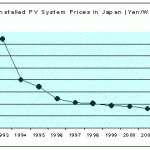India’s Solar Power Potential

One third of the population (over 450 Million) have no access to power
India’s Power Supply and Demand gap hovers around 8%-10% deficit from the last ten years.
India’s National Electricity Policy aims at an availability of 1000 kWhr per capita per year by 2012.
The two maps above indicate the solar mapping of India’s Potential Solar Radiation Solar PV will become progressively more attractive as the costs go down and the supports from the government also comes to further aid.
Solar PV has largely a great impact on the off-grid options and hence the states such as Rajasthan have a tremendous opportunity to reap from the availability of high Irradiation. This also has a huge impact on the village electrification programs since Solar PV can be a great local power options where the Grid power is unavailable.
We are showing a simple way by which Solar PV could be connected for domestic power needs and if required can feed the surplus power through Grid synchronization. As of now, the Grid synchronization is expensive and unless the capital costs are subsidized through aid programs , it still remains an economic challenge.
Advantages
The local source of power solving the rural electrification challenges
Reduced dependence on Kerosene which could mean annual savings of 10,000 to 20,000 crores that the government spends by giving subsidies.
Reduction of diesel usage which is currently a big drain on national reserves, and a major cause of air pollution.
Additionally Solar PV could power the irrigation pumps which can itself be a huge market. Considering almost 50% of rural population involved in direct or indirect agriculture.
The state or central government subsidy for rural electricity is to the tune of 30,000 to 40,000 crores.
Another big potential is +200,000 cell phone towers that need remote power at a localized level. Supplying electricity to these towers via grid power can be a big challenge. So solar PV comes into the picture here too.
All the above results in employment generation of more than 150,000 by 2020 besides transforming the lives of all involved directly or indirectly.
The lists can go on but the conclusion is that we are sitting on a gold mine of an opportunities. All we have to do is to organize ourselves and reap the benefits of Solar PV for India
The above translates into an increase of 450 billion kWh of additional availability of power.
Our current dependence of power generation from fossil fuels is above 62% and our coal reserves are left for a few decades only.
Our Carbon footprint by the year 2030 would be 1.4 billion metric ton of CO2 (approx 7% of the Global emission)
With all the above mentioned challenging facts, there is a brighter side too. A large part of India is endowed with abundant solar radiation. The figures range from 4 to 7 Kwh per square meter per day. Inspite of regional and daily variation, the average figures are promising. India has more than 300 sunny days, every year. Theoretically speaking approximately 2000 kWh of electricity could be produced per kWp of PV capacity.

